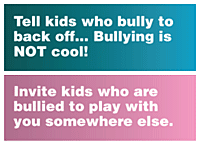Bullying typically involves three individuals or groups; the person doing the bullying, the person being bullied and the bystanders. It is often the group of bystanders who have the most power to put an end to bullying – they are the largest group and they have not had their self esteem repeatedly tested to a point where they are so emotionally fragile and unable to stand up and speak out. It is for these reasons, among others, that we as caregivers and parents need to focus our attention on this group and encourage them to be the change needed to put an end to violence and bullying.
Help bystanders understand what an important role they play when witnessing bullying through:
- Helping to raise their empathy for victimized children and their awareness of individual responsibility.

- Communicating that bullies love an audience. Those who stand by and do nothing make bullying worse if they support or cheer-on the bully.
- Encouraging them to think about what they would expect from others if they were in a similar situation as the person being bullied.
- Talk about the anxiety around possibly being the next victim and being in an unsafe environment.
Children who understand the importance they play in bullying episodes are more likely to step in on behalf of the child being bullied. But! Even children who empathize and/or sympathize with victims of bullying are still often time reluctant to step in and help.
- Bystanders fear being the next target
- They think they will cause more harm than good (they don’t fully understand the process of bullying and don’t have the knowledge or skills to intervene effectively, worrying that they may make matters worse for the victim)
- They justify not getting involved because the person being bullied is not really their friend
- They find it difficult to intervene in the reality of playground life
- There is a ‘diffusion of responsibility’ among the crowd
The bottom line here is….”the attitudes of most children are found to be against bullying, yet most children act in ways that maintain and encourage bullying rather than reducing it.”
Some of the reasons given for not intervening on behalf of the victim are valid, however, it is our job as a responsible society to encourage a different way of thinking that can eliminate some of the reasons behind not stepping in when witnessing bullying. We can educate on the dynamics of bullying, we can reinforce that bullying is unacceptable – period, and we can help our children learn appropriate and effective methods of intervening:
- Choosing not to watch and walking away (taking away the audience)
- Being kind to the person being bullied at another time
- Telling the person being bullied that you don’t like the bullying and asking them if you can do anything (tell someone or go with them to tell someone)
- Telling the children doing the bullying that you don’t like it and to stop doing it (but only if this feels safe to do)

- ‘Scooping up’ the child by taking them by the arm and saying something like ‘Come on, we need you for our game’(again, only if it feels safe to do so)
- Saying ‘No, we don’t like that’ is very effective in the early years. Children are taught to put out their hand to sign ‘stop’ and act and speak assertively together
- Practice assertiveness skills, through role-playing and discussion in the classroom and/or at home
- Validate the bullied child’s experience after the event will reassure them that they were supported
- Create opportunities to contribute to the anti-bullying culture of a school through creating posters, stories or films
- Accompany your child to the teacher or principal if they decide to report what they have witnessed
- Encourage your child to mobilize his/her friends to join together to protect the victim. There is safety in numbers
- Encourage children to seek help if needed from an adult
———————————————————————————–
Participant or Bystander Roles:
Assistants – join in and assist the bully.
Reinforcers – do not actively attack the victim but give positive feedback to the bully, providing an audience by laughing and making other encouraging gestures.
Outsiders – stay away, not taking sides with anyone or becoming involved, but allowing the bullying to continue by their ‘silent approval’.
Defenders – show anti-bullying behavior, comforting the victim, taking sides with them and trying to stop the bullying.
Bullying is, thus, seen to be a group phenomenon in which a variety of players contribute a number of roles, pressures and influences, either intentionally or unintentionally, and ‘are substantially involved in playground bullying, whether
as active participants or as bystanders who are unable or unwilling to act pro-
socially’ (O’Connell and others 1999).
Encourage Your Children to be Defenders!!!
———————————————————————————–
